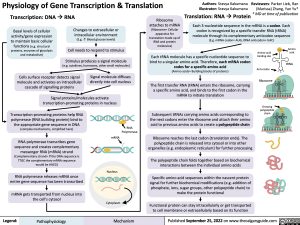Physiology of Gene Transcription & Translation
Authors: Sravya Kakumanu Reviewers: Parker Lieb, Ran Illustrator: Sravya Kakumanu (Marissa) Zhang, Yan Yu*
Translation: RNAàProtein * MD at time of publication Each 3-nucleotide sequence in the mRNA is a codon. Each
codon is recognized by a specific transfer RNA (tRNA) molecule through its complementary anticodon sequence (E.g. mRNA codon= AUG, tRNA anticodon= UAC)
Transcription: DNAàRNA
Ribosome attaches to mRNA (Ribosome= Cellular apparatus for translation made up of RNA and protein molecules)
Basal levels of cellular activity/gene expression to maintain basic cellular functions (e.g. structural proteins, enzymes of glycolysis and metabolism)
Changes to extracellular or intracellular environment (E.g. ↑ Blood glucose levels)
Cell needs to respond to stimulus
Stimulus produces a signal molecule (e.g. cytokines, hormones, other small molecules)
Each tRNA molecule has a specific nucleotide sequence to bind to a singular amino acid. Therefore, each mRNA codon
codes for a specific amino acid
(Amino acids= Building blocks of proteins)
The first transfer RNA (tRNA) enters the ribosome, carrying a specific amino acid, and binds to the first codon in the mRNA to initiate translation
Subsequent tRNAs carrying amino acids corresponding to the next codons enter the ribosome and attach their amino acid to previous amino acids to create a polypeptide chain
Ribosome reaches the last codon (translation ends). The polypeptide chain is released into cytosol or into other organelles (e.g. endoplasmic reticulum) for further processing
The polypeptide chain folds together based on biochemical interactions between the individual amino acids
Specific amino acid sequences within the nascent protein signal for further biochemical modifications (e.g. addition of phosphate, ions, sugar groups, other polypeptide chain) to make the protein functional
Functional protein can stay intracellularly or get transported to cell membrane or extracellularly based on its function
Amino Amino-acid acid
Cells surface receptor detects signal molecule and activates an intracellular cascade of signalling proteins
Signal molecule diffuses directly into cell nucleus
binding site
Anti-codon Ribosome
Growing polypeptide chain
tRNA
Signal proteins/molecules activate transcription-promoting proteins in nucleus
Transcription-promoting proteins help RNA polymerase (RNA building protein) bind to the appropriate gene sequence in DNA (complex mechanisms, simplified here)
RNA polymerase transcribes gene sequence and creates complementary messenger RNA (mRNA) strand (Complementary strand= If the DNA sequence is TTGC the complementary mRNA sequence
would be AACG)
RNA polymerase releases mRNA once entire gene sequence has been transcribed
mRNA gets transported from nucleus into the cell’s cytosol
RNA Polymerase
mRNA
Nucleus
Cytoplasm
Legend:
Pathophysiology
Mechanism
Published September 25, 2022 on www.thecalgaryguide.com
Foundations
Systems
Other Languages
Physiology Medical Genetics Physiology of Gene Transcription & Translation physiology-of-gene-transcription-translation

